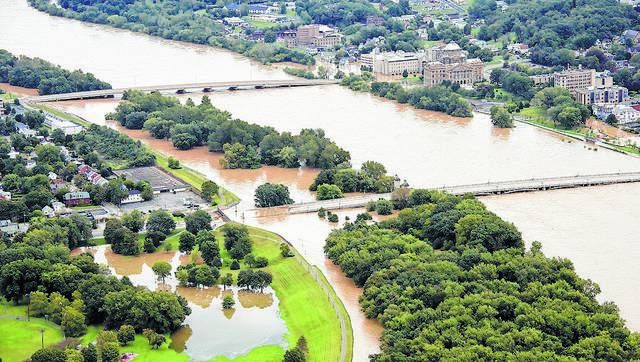Click here to subscribe today or Login.
Christopher Belleman must battle groundhogs, tire ruts and encroachers to keep the Wyoming Valley Levee certified, but he said efforts are paying off.
“We’re heading in the right direction,” said Belleman, executive director of the Luzerne County Flood Protection Authority that oversees the 16-mile flood-control system along the Susquehanna River.
In an exhaustive annual inspection, the U.S. Army Corps of Engineers rates the levee’s performance in 63 categories, ranking each as acceptable, minimally acceptable, unacceptable or nonapplicable. The local levee is divided into three “reaches” — Plymouth, Wilkes-Barre to Hanover Township and Kingston to Exeter.
Compared to the 2015 inspection, the number of categories ranked acceptable increased from 42 to 52 in the Wilkes-Barre/Hanover reach and from 38 to 53 in the Kingston/Exeter for 2018, Belleman said Monday. The number remained at 44 in the Plymouth reach.
The latest inspection also eliminated three past unacceptable ratings, leaving none to address, his analysis shows.
Overall, the levee recently received a minimally acceptable certification, which is the same ranking the system has received since the federal government imposed tougher standards after Hurricane Katrina, he said.
Fewer than 10 of the 1,400 levees the Army Corps oversees across the country have the acceptable rating, and most of these are newer and smaller systems, Belleman said, noting the federal agency is considering changing the wording of the minimally acceptable category based on feedback it is creating a misconception these systems are not properly equipped to handle flooding.
Tackling challenges
Groundhog burrows are one of the 2018 findings that will be addressed, Belleman said.
Inspectors found burrows in drainage areas in Wyoming and Pringle. The animals will be euthanized with a method involving carbon dioxide cartridges and blocking of burrow openings that has been used in the past, he said. He doesn’t want to resort to shooting the animals due to the risk of an errant bullet. The effort is necessary to protect the levee and satisfy inspectors, he said.
“There have been some levees that failed due to massive burrows by groundhogs. We don’t have that here. We just have an isolated issue,” Belleman said.
To eliminate ruts frowned upon by the Army Corps, Belleman has instructed levee crews to reconfigure the pattern in which they mow the grass, which serves as a protective turf cover. A growth-retardant herbicide also has been deployed to reduce the frequency of mowing, allowing ruts to heal and lowering equipment wear-and-tear, he said.
While damage from illegal all-terrain-vehicle wear is still a concern, a crackdown involving ATV prohibition signs and citations has largely reduced such trespassing, he said.
Another continued finding involves encroachment in various areas. The Army Corps does not want structures, tree branches or fences within 15 feet of the levee base.
The inspection pointed out a pipe a property owner had installed to drain water onto the levee base. After the owner ignored a removal demand, the authority has capped the pipe, Belleman said. The authority is working with other property owners who have a fence and shed installed too close to the levee, he said.
“We’re constantly looking for encroachments. It’s a lot better now than it was when I first got on board,” Belleman said.
The authority picked up more acceptable ratings in part due to unwanted vegetation removal, relief well and pipe penetration inspections and repairs to the maintenance road atop the levee, he said.
Continued improvement
U.S. Army Corps representatives inspected the levee last month for the 2019 certification, which likely will be released around March 2020, Belleman said. Some inspectors told him the local system was “one of the better, well-maintained” levees, he said.
Acceptable ratings should increase because authority staffers are in the process of replacing the sealant of joints in the levee wall concrete casing in Forty Fort — a job being performed in-house to save hundreds of thousands of dollars, he said.
Joints filled with sealant were necessary to allow the concrete to expand and contract and prevent cracks. The concrete covers interlocked steel sheet pile that provides the primary flood protection.
A sheetpile flood wall in Exeter also will be repainted to restore its protective covering, which also was pointed out as a deficiency, he said.
Another project to repaint and make other improvements at the 12 tubes drainage structure in Wyoming may be delayed until 2020 or 2021 because the bids came in too high, Belleman said.
Belleman said he will continue trying to fix lingering issues and prevent new ones without exceeding the authority’s $1.9 million budget, which comes from a fee on levee-protected properties.
“I’m taking the long-term view that little by little, year after year, we just kind of chip away at the deficiencies,” he said. “With time and money there’s no reason why we couldn’t get an acceptable certification. We’re close now.”





